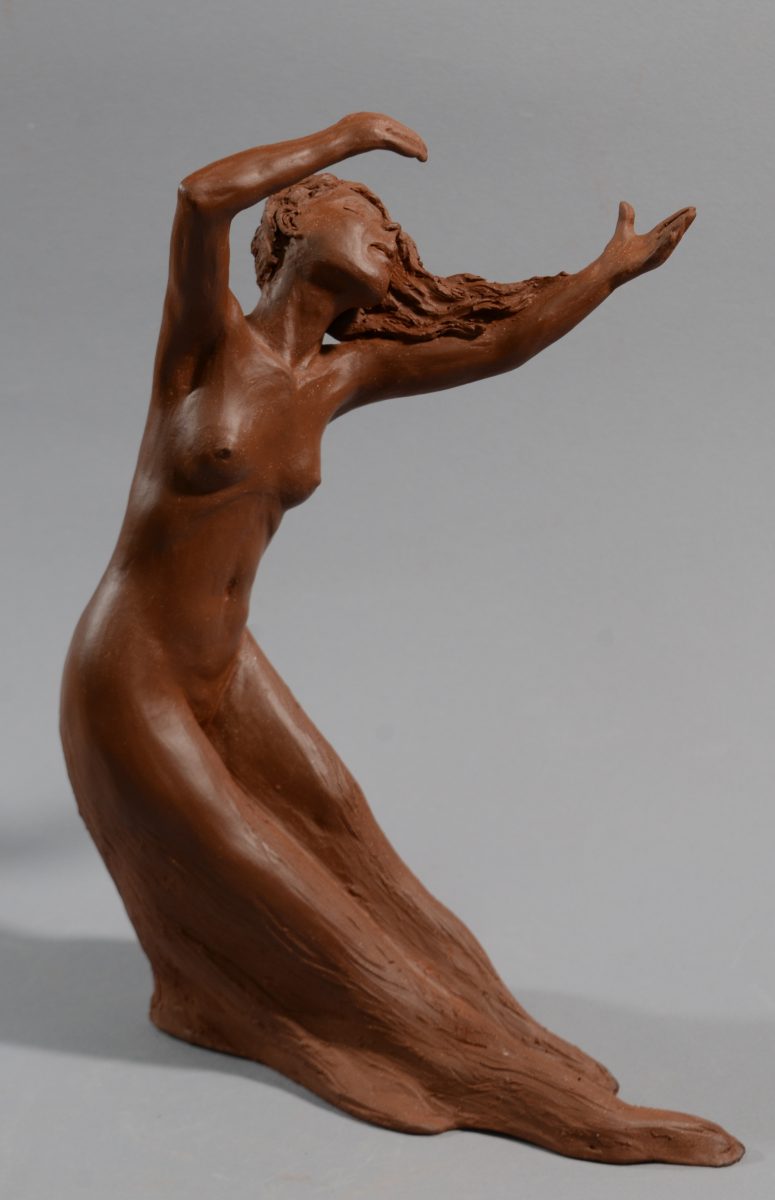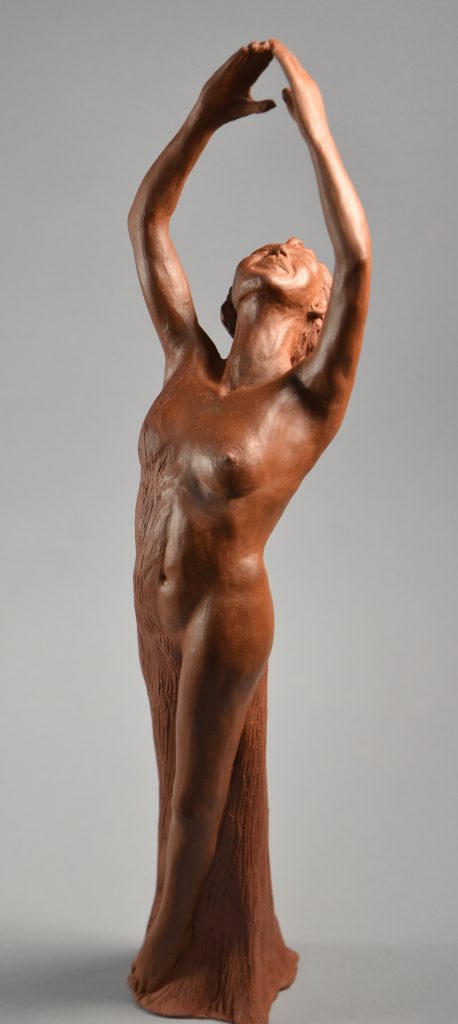I have created a number of sculptures in a series based on the ancient Greek mythology of the Dryads. Each figure was based on the idea of “the soul of the tree”. My primary exposure has been through the Narnia series, written by C.S. Lewis, where he incorporated the dryads as the “talking trees“, much like the talking animals which populated his fantastic world. In Lewis’ telling, these characters spent much of their time as standing trees, in many ways indistinguishable from any other simple tree. However, when the need arose, they could step out of the tree-form looking much like a human being. One of the fascinating things about Lewis’ description of the Narnia dryads was that you could always tell what kind of tree the human-form dryad came from, since their look and personality mirrored the character of the tree.
Deeply Rooted
I have written more about this piece in a blog post from early 2015, but I wanted to include it here, since, in many ways, this marks the foundation of my work with dryads.
Around that time, I attended a retreat with our team. One of the activities involved spending time in individual prayer and listening. As I began to settle in, an unexpected phrase popped into my head: “I can’t do anything right!” This surprised me at first, but then I remembered an incident, not long before. Criticism was coming at me from without and within, and I finally blurted out in frustration, “I can’t do anything right!”
As I began to turn over this phrase that was bugging me, it began to intertwine with my memories of C.S. Lewis’ descriptions of the talking trees.
The tree doesn’t spend time worrying about how to grow, or how to produce fruit. Those things are built into the nature of the tree, in its DNA. As long as the tree remains deeply rooted, growth and fruit come as a result of the way it is created. Through Christ, I am being transformed into His likeness. I have been given His character — His spiritual “DNA” — inside of me. My roots grow deep as I live, day by day, in fellowship with Christ and other Christians. In many different and practical ways, that nature inside of me begins to produce fruit.
Willow Dryad
As I continued to push into the idea of the dryads, I created another figure a short time later (2015). This was the diminutive Willow Dryad. I tried to capture the sense of the willow tree, with its thin, wispy branches and long flowing leaves coming almost all the way to the ground. I used a touch of a green glaze on her hair (as well as the grass at her feet), and made her body and arms especially slender, leaning a little to one side as she looks sideways at you through the falling hair almost covering her face.
The Oak Dryads
The oak tree is known for its strength and great age. It is a symbol of stability, vitality, and wisdom.
These two sculptures were actually not intended as a pair. I created the first one (female) in 2016 when I was a student at the Incarnate School of Art and Mission, in Isola, Italy. I was able to find some clay there, and even connected with a local ceramic artist who would fire some of the pieces I created. When I left at the end of the program, I wasn’t sure the figure would survive the trip home, so I left it with the center.
Two years later, participating in a similar program being held at the same location, I created the male dryad figure, also growing out of the symbolism of the Oak tree. I had forgotten about the first one, somewhere in storage. When the other staff at the venue saw the figure, they went and found the first dryad, only to discover that they were (accidentally) and almost perfectly matched set!
Cedar Dryad
The cedar tree is seen as a symbol of greatness, nobility, strength, and of incorruptibility.
I created this female version around 2017, trying to capture the character of strength, reaching up to the heavens, even as she begins to step out of her tree form.
Stylistically, I was creating a slightly different form of the transition between tree and human forms, with the surface of the bark extending up her torso, more along the lines of the original Oak dryads.
A note on the gender of the dryads: There are some variations in the mythology, but technically, a dryad is always a female. The male version is sometimes called a dryas or a drus. There is some discussion as to whether there were any male tree nymphs/dryads in the world of Narnia, but I thought it would be interesting to create both.
Cedar Dryad (male)
Just as with the earlier female version of the Cedar Dryad, I often think of the symbol of “The Cedars of Lebanon”, which is seen on their national flag. I wanted to portray the strength of character and the sense of protection and provision, as a great father standing over his children.
One aspect of this sculpture, which you need to look carefully to see, is the fact that a significant crack opened in the chest of this figure as he went through the firing process. Something I have incorporated into several of my sculpture pieces as they have experienced similar stresses, is the ancient Japanese ideal of kintsugi, or “mended with gold.” I was able to use a gold-like material to fill in the crack, as a reminder that he too has walked through struggles and come out stronger and more precious in the end.
Beech Dryad
Around the same time as I was working on the Cedar dryad, I wanted to portray a softer, more gentle kind of tree. The Beech tree has long been a favorite of mine. The Beech as long symbolized knowledge, as well as protection and nurturing. There is some thought that the word “beech” may be the origin of the word “book” because beech bark was used as writing material.
 A peculiar characteristic of the root systems is that the roots coming out of the base of the tree often skitter and twist across the surface of the ground, crossing over each other before then sink into the soil around the tree.
A peculiar characteristic of the root systems is that the roots coming out of the base of the tree often skitter and twist across the surface of the ground, crossing over each other before then sink into the soil around the tree.
Something I had seen myself was that, due to the very smooth nature of the bark of the beech, it is often a favorite place for people to carve words, or maybe their names into the smooth trunk. I added my initials as well as my wife’s initials… surrounded by the classic heart.
Old Mother Willow
Another example of the mythology of the dryad or tree-spirit can be the ancient willow tree. A version of the old Grandmother Willow shows up in the Disney Pocahontas movie. The willow is known as a symbol of immortality and rebirth, strength and stability, wisdom and patience. As I created the willow, I wanted her to show a different kind of enduring beauty, outlined by the wrinkles in her face and physique, as well as the sparkle in her smile. The figure doesn’t have to be young and slender to live in her beauty.
I wanted to mirror her long hanging branches with the long hair she is holding, and the core of the tree with her deep roots and signs of old injuries she has weathered in all of her years.
Birch Dryad
The birch tree is a familiar sight, with its stunning white bark. As a kid, I remember stripping birch bark (off of downed trees, not live standing ones!) to create a kind of paper to write on or do other crafts. I think I even sent some letters home from summer camp on birch bark a couple of times.
 One of the lesser known attributes though, one which may be familiar to you if you ever had a small clump of birch trees in your yard, is that fact that birch trees do not have a long lifespan. A white birch may live to 60-70 years, or much less if under stress. Compare with an oak tree and its average lifespan of 600 or more years.
One of the lesser known attributes though, one which may be familiar to you if you ever had a small clump of birch trees in your yard, is that fact that birch trees do not have a long lifespan. A white birch may live to 60-70 years, or much less if under stress. Compare with an oak tree and its average lifespan of 600 or more years.
As I was creating this figure, I wanted to give her a similar sort of young woman with an attitude posture. I was fascinated with the sculpture by Edgar Degas of the Little Dancer of Fourteen Years, with her defiant stance, and the little ribbon tying back her hair.
With her hands on her hips and her shoulders thrown back, I think she knows who she is, and she’s not about to let anyone push her around.
His Voice on the Wind
 While this piece isn’t strictly a “tree person”, it bears many of the same characteristics of a human figure emerging out of something found in nature. In this case, it’s not clear if this is a tree, a wave, or a rock feature, but the figure is most important.
While this piece isn’t strictly a “tree person”, it bears many of the same characteristics of a human figure emerging out of something found in nature. In this case, it’s not clear if this is a tree, a wave, or a rock feature, but the figure is most important.
This is an example of a figure where I didn’t have a specific title or theme as I was building it, where the figure grew dynamically as I worked with the clay. The sense I had was of longing — reaching for something just beyond her grasp as she stood buffeted by the wind. Something was calling to her…
Sometimes, as I finish a piece, I will take time to just sit with it, watching it, feeling the story that the piece itself begins to tell me. What she told me about herself was that she was longing for, listening for, “His voice on the wind.” So, that became her name.
As I have walked through this series of sculptures, I have seen and learned many things along the way — lessons of strength, peace, assurance in our place, living out who we have been created to be. It’s not easy to step away from the criticism which has become so common these days (especially on social media), to put aside the “impostor syndrome”, but it is the only way to live in the reality of producing fruit.








